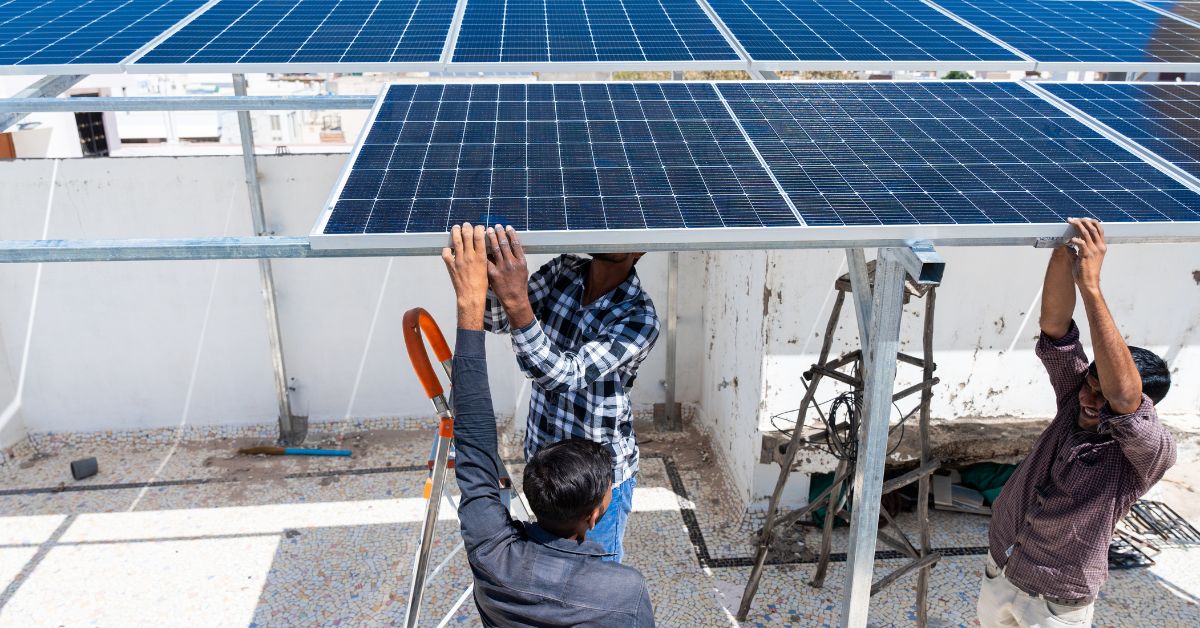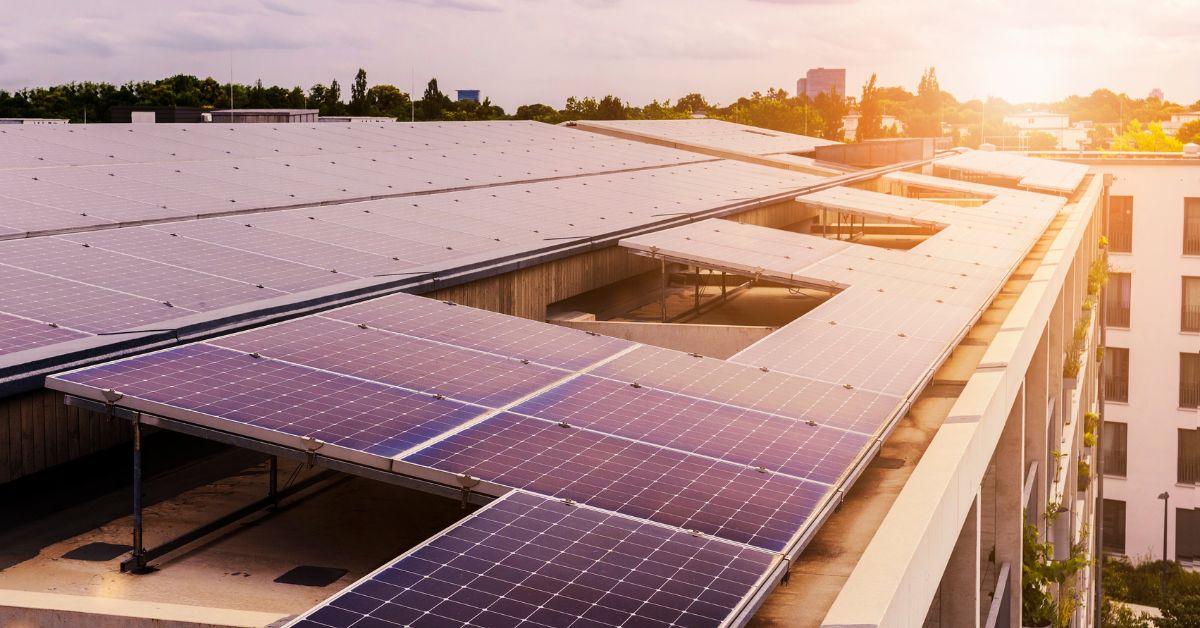From Noida to Gurugram and Bengaluru to Kochi, apartment buildings and rentals are becoming increasingly common across India. One of the main concerns of these apartment owners and tenants is how they would affordably and sustainably power them for an extended period of time.
Installing a solar system has emerged as the best investment for flats to reduce monthly electricity bills, and cater to the rising power demand in residential areas.
One of the progressive societies, the Palash Co-Operative Housing Society of Pune, stands out amid the concrete highrises in the city. It installed solar panels with a capacity of 66 kW that help light all the common spaces in the complex spanning across four acres.
Similarly, a 19-storey-high rise Bhoomi Arkade in Mumbai has installed 40 solar panels, each with a 12-kW capacity, that generate 55-60 units of electricity daily which power common lights, fans, lifts, and water pumping stations. It saves the residents a whopping Rs 2.6 lakh on power bills annually.
We sat down with Kiran Vadgama, the chairman of the Palash Society, and Harish Shakar Kate, the secretary of Bhoomi Arkade, to get an understanding of how residents of apartment complexes and rentals can harness solar energy to reduce their power bills.

15 factors to consider for solar panel installation
Kiran opines that if societies harness solar energy then it would be a big boon for flat purchases and the load on the grid would be very minimal in mega cities like Mumbai, Pune, Bengaluru, Kolkata, Hyderabad, and Delhi.
It would be cost-effective for every individual flat purchaser and tenant as well. He points out that they can accommodate this kind of infrastructure easily.
Kiran and Harish share 15 key points to consider for solar panel installation for apartments and rentals:
- Firstly, look for organisations like Tata Power, Kosher, and Havells who will provide technical support and customer care services to guide and counsel you on the installation and financing of the panels.
- Conduct shadow analysis to assess how much solar energy can be captured in a specific place by checking how objects like trees and towers affect the solar setup. It takes about 3 to 6 months to conduct shadow analysis. The installation company comes every week to check the shadow and the sunlight being received in order to finalise the panel location before the infrastructure installation.
- A family of five living in a 2BHK can choose to install 2 kW for 100 percent dependency on solar energy. It doesn’t require a lot of space and is ideal for properties with space constraints. It should suffice energy requirements for using two air conditioners, five lights, and fans. The cost of solar panel installation is expected to be Rs 1 lakh and it takes between 15 to 45 days for installation.

- Usually, the life of the solar panels is 25 years. A majority of the inverters sold in India have a warranty lifespan of 5 to 6 years. You will have to replace them multiple times which would increase your cost capital tremendously. Opt for inverters with a replacement warranty of 10 years so that you only replace it once. While this would cost you an additional Rs 1 lakh, it will save you on recurring battery replacement costs.
- Bird droppings obstruct the sunlight that solar panels require to generate power. Therefore, you must routinely remove bird droppings from your solar setup. Install transponders that will transmit the live readings to you and show which panel is not generating enough electricity. Immediately, clean the panel to avoid malfunctions.
- Depending on the shadow analysis, you can recover the investment costs in 4-6 years from the year of solar installation. Once you get your return on investment, you’ll get free power.
- Apartment owners or tenants can install solar panels on their balconies provided they receive sufficient sunlight. A person living on the second floor and 20th floor will receive different amounts of sunlight. If you have a building surrounding your view and there’s no sunlight, then it won’t be a viable option as the efficiency levels will reduce.
- Consider the area of coverage on your balcony. If your balcony is 12-feet long, you will be able to place 3-4 panels. You also require space to keep inverters as well.
- As an apartment owner, you can choose to install solar panels on the terrace of your apartment complex and the society cannot refuse the request, provided there is a vacant space available on the rooftop. You can move the court if the society denies your request.

- It is to be noted that if you live on, say, the second floor of a 20-storey building, the cost of bringing the cable (wire) down from the terrace would be enormous. The add-ons could run into an additional Rs 1 lakh.
- In this case, you can opt for balconies which can minimise the cabling cost as the whole system would be drawn to your house including the net metre. It’s a viable proposition for apartment owners and tenants with rental agreements for 10 or 15 years. Tenants cannot remove the setup to take it somewhere else because it will again involve paperwork and installation costs.
- Let’s assume the monthly power expenses to be Rs 2,500 and the cost of installation and inverter (with a 10-year warranty) to be Rs 1.5 lakh. So, for a 15-year contract, the return on investment will be generated only after five years and residents can avail of eight years of free electricity provided the inverter lasts for say 13 years. Later on, the landlord will incur the capital cost for the new inverter.
- Highlighting the challenges on the terrace and balconies, Harish mentions that residents will have to bear metre and wiring expenses that can go up to Rs 1 lakh. Using balconies could not be very feasible if the energy generation will be small-scale compared to the requirement. In the case of balconies, there are safety risks from extreme weather events like lightning strikes, strong winds, and cyclones that can damage the panels.
- Kiran points out that there’s a lot of paperwork involved with the concerned electricity boards. For instance, the contract term with the concerned electricity provider and the subsidy. The service provider and the solar installation companies will help do the paperwork but ensure that you keep a copy of all the documents.
- He further asks residents to consider the maths on subsequent savings. If your monthly power bill is Rs 2,500 in a 2BHK, then you will recover the cost of solar installation in 10 years (assuming rooftop cable wiring expenses in addition to inverter and installation costs totaling Rs 3 lakh). It does not make sense if the monthly bill is Rs 1,000-1,200 and tenants move out shortly after.
(Edited by Padmashree Pande; Photo credit: Adobe stock images, Bhoomi Arkade, and Palash Co-Operative Housing Society)
No comments:
Post a Comment